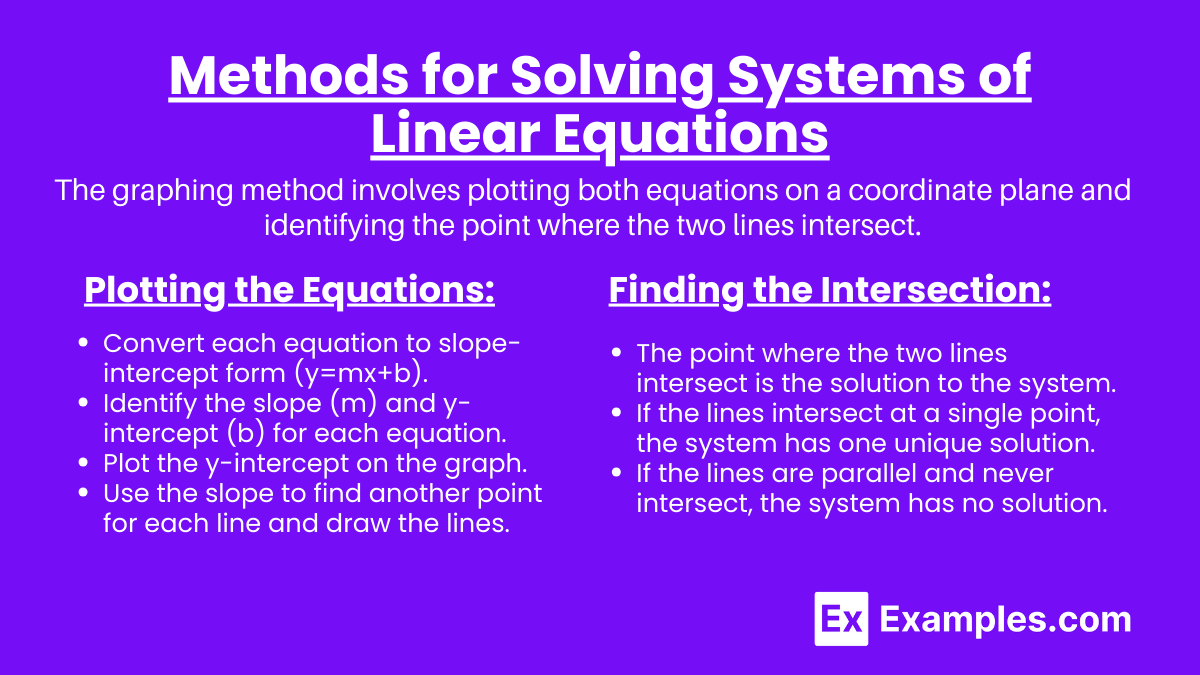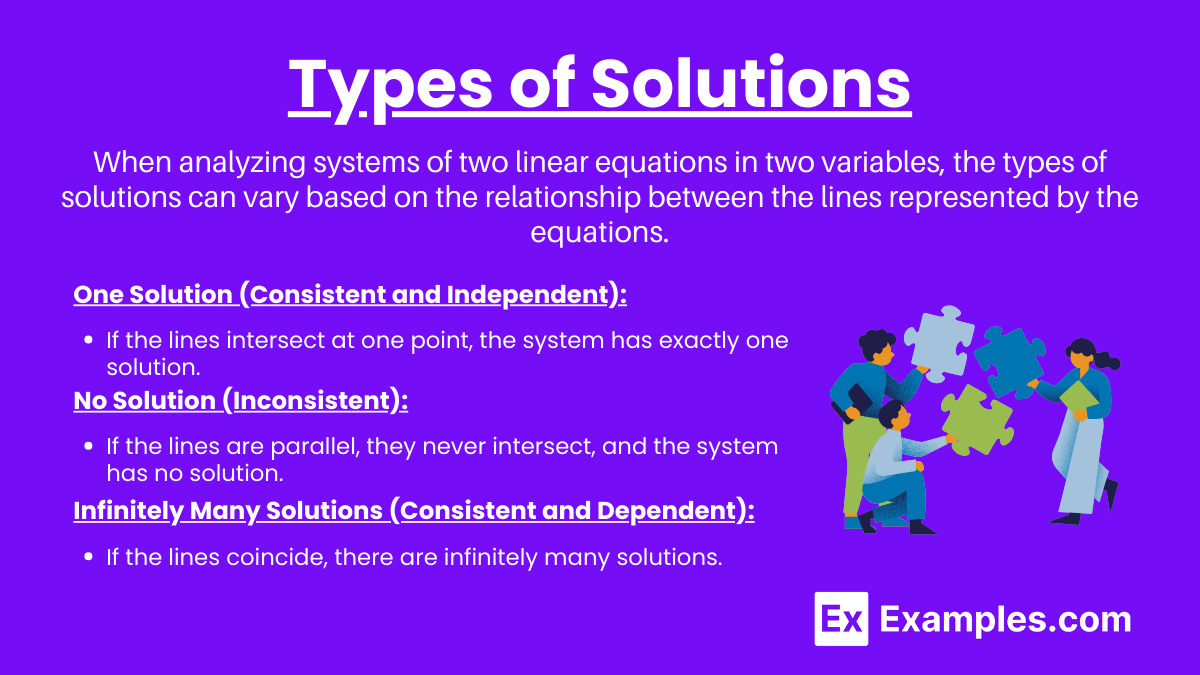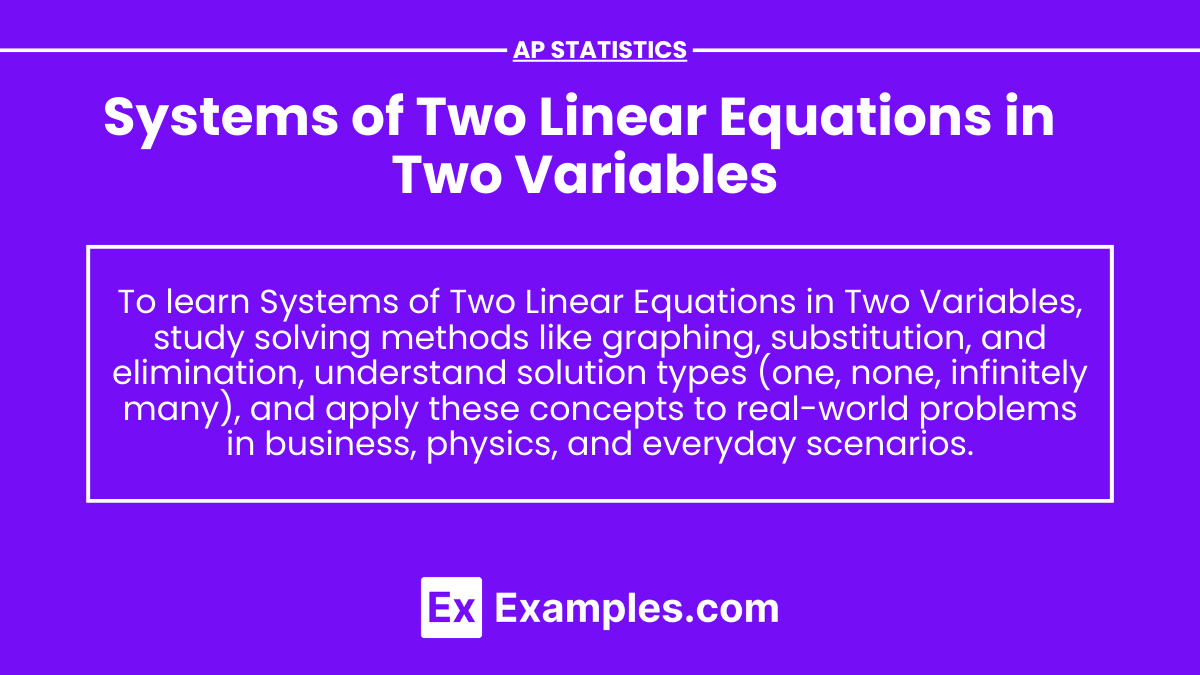A system of two linear equations in two variables, a topic frequently encountered on the Digital SAT exam, involves two equations that are both linear, meaning they can be represented graphically as straight lines. Each equation typically has the form ax+by=c, where a, b, and c are constants, and x and y are variables. Solving such a system means finding the values of x and y that satisfy both equations simultaneously. These solutions can be found using various methods, including graphing, substitution, and elimination. Understanding these systems is crucial for solving many real-world problems where relationships between two quantities need to be analyzed and understood.
Learning Objectives
By the end of this lesson, you will be able to understand and solve systems of two linear equations in two variables using graphing, substitution, and elimination methods. They will learn to interpret the solutions of these systems in the context of the problems they represent, determine the number of solutions a system can have, and apply these methods to real-world scenarios, thereby gaining a comprehensive understanding of the topic and its applications in various mathematical and practical contexts.
Methods for Solving Systems of Linear Equations

The graphing method involves plotting both equations on a coordinate plane and identifying the point where the two lines intersect. This point of intersection represents the solution to the system, as it satisfies both equations simultaneously.
- Plotting the Equations:
- Convert each equation to slope-intercept form (y=mx+b).
- Identify the slope (m) and y-intercept (b) for each equation.
- Plot the y-intercept on the graph.
- Use the slope to find another point for each line and draw the lines.
- Finding the Intersection:
- The point where the two lines intersect is the solution to the system.
- If the lines intersect at a single point, the system has one unique solution.
- If the lines are parallel and never intersect, the system has no solution.
- If the lines coincide (are the same line), the system has infinitely many solutions.
Substitution Method
The substitution method involves solving one of the equations for one variable and then substituting that expression into the other equation.
- Solve for One Variable:
- Choose one of the equations and solve for one of the variables in terms of the other (e.g., x=2y+3).
- Substitute and Solve:
- Substitute this expression into the other equation to get an equation with one variable.
- Solve this new equation for the single variable.
- Back-Substitute:
- Substitute the value of the solved variable back into the equation from step 1 to find the value of the other variable.
Elimination Method
The elimination method involves adding or subtracting the equations to eliminate one of the variables, making it possible to solve for the remaining variable.
- Align the Equations:
- Write both equations in standard form (ax+by=c).
- Eliminate a Variable:
- Multiply one or both equations by appropriate numbers so that the coefficients of one of the variables are opposites.
- Add or subtract the equations to eliminate one variable.
- Solve for the Remaining Variable:
- Solve the resulting single-variable equation.
- Substitute this value back into one of the original equations to find the other variable.
Types of Solutions

When analyzing systems of two linear equations in two variables, the types of solutions can vary based on the relationship between the lines represented by the equations. There can be a unique solution, no solution, or infinitely many solutions. Understanding these different scenarios is crucial for correctly interpreting the results of solving such systems.
- One Solution (Consistent and Independent):
- If the lines intersect at one point, the system has exactly one solution.
- The equations represent two different lines.
- No Solution (Inconsistent):
- If the lines are parallel, they never intersect, and the system has no solution.
- The equations represent parallel lines with the same slope but different y-intercepts.
- Infinitely Many Solutions (Consistent and Dependent):
- If the lines coincide, there are infinitely many solutions.
- The equations represent the same line (they are multiples of each other).
Real-World Applications

Systems of two linear equations in two variables can model various real-world situations, providing powerful tools for analysis and problem-solving in numerous fields. Understanding and applying these systems can help address complex issues in business, economics, physics, chemistry, and everyday life.
- Business and Economics:
- Determining the break-even point where revenue equals cost.
- Analyzing supply and demand to find equilibrium prices and quantities.
- Physics:
- Solving problems involving forces in equilibrium.
- Analyzing electrical circuits with multiple loops.
- Chemistry:
- Balancing chemical equations by finding the right proportions of reactants.
- Everyday Life:
- Planning budgets and expenses.
- Determining the best combinations of ingredients in recipes.
Examples of Systems of Two Linear Equations in Two Variables
Example 1: Solving by Graphing
Problem:
Solve the system of equations by graphing: y=2x+3 y=−x+1
Solution:
- Graph the Equations:
- For y=2x+3:
- The y-intercept is 3.
- The slope is 2, so from the y-intercept (0, 3), go up 2 units and right 1 unit to get another point (1, 5).
- Plot the points (0, 3) and (1, 5) and draw the line.
- For y=−x+1:
- The y-intercept is 1.
- The slope is -1, so from the y-intercept (0, 1), go down 1 unit and right 1 unit to get another point (1, 0).
- Plot the points (0, 1) and (1, 0) and draw the line.
- For y=2x+3:
- Find the Intersection:
- The lines intersect at the point (−1, 1).
- Solution:
- The solution to the system is x=−1 and y=1.
Example 2: Solving by Substitution
Problem:
Solve the system of equations using substitution:
x+y=7
2x−y=1
Solution:
- Solve for One Variable:
- From the first equation, solve for y:
y=7−x
- From the first equation, solve for y:
- Substitute into the Second Equation:
- Substitute y=7−x into the second equation:
2x−(7−x)=1
2x−7+x=1
3x−7=1
3x=8![Rendered by QuickLaTeX.com \[x=\frac{8}{3}\]](https://www.examples.com/wp-content/ql-cache/quicklatex.com-2649b150c0949f55cef33bb61040d612_l3.png)
- Substitute y=7−x into the second equation:
- Find the Other Variable:
- Substitute
back into y=7−x:![Rendered by QuickLaTeX.com \[x=\frac{8}{3}\]](https://www.examples.com/wp-content/ql-cache/quicklatex.com-2649b150c0949f55cef33bb61040d612_l3.png)
![Rendered by QuickLaTeX.com \[\ y=7-\frac{8}{3}\]](https://www.examples.com/wp-content/ql-cache/quicklatex.com-32f66b7b30b0d515d11584c722d83572_l3.png)
![Rendered by QuickLaTeX.com \[\ y=\frac{21}{3} - \frac{8}{3}\]](https://www.examples.com/wp-content/ql-cache/quicklatex.com-94d1bcded78fce62c6360a27bfe6e7e8_l3.png)
![Rendered by QuickLaTeX.com \[\ y=\frac{13}{3}\]](https://www.examples.com/wp-content/ql-cache/quicklatex.com-16c5a3734c2c0061a6756326b25b51e9_l3.png)
- Substitute
- Solution:
- The solution to the system is
and![Rendered by QuickLaTeX.com \[x=\frac{8}{3}\]](https://www.examples.com/wp-content/ql-cache/quicklatex.com-2649b150c0949f55cef33bb61040d612_l3.png)
.![Rendered by QuickLaTeX.com \[y=\frac{13}{3}\]](https://www.examples.com/wp-content/ql-cache/quicklatex.com-aea8102844333e6e3eb8bb845310fe6a_l3.png)
- The solution to the system is
Example 3: Solving by Elimination
Problem: Solve the system of equations using elimination:
3x+4y=24
2x−4y=4
Solution:
- Add the Equations:
- Align the equations and add them to eliminate y:
![Rendered by QuickLaTeX.com \[ (3x + 4y) + (2x - 4y) = 24 + 4 \]](https://www.examples.com/wp-content/ql-cache/quicklatex.com-8a00f1ba6ff7ced7a8319c4e60d4d927_l3.png)
![Rendered by QuickLaTeX.com \[ 5x = 28 \]](https://www.examples.com/wp-content/ql-cache/quicklatex.com-1c7eff789ed09fca6490a73cc9313ff1_l3.png)
![Rendered by QuickLaTeX.com \[ x = \frac{28}{5} \]](https://www.examples.com/wp-content/ql-cache/quicklatex.com-0719210eeef9c9cb894bc24ddde29bdb_l3.png)
![Rendered by QuickLaTeX.com \[ x = 5.6 \]](https://www.examples.com/wp-content/ql-cache/quicklatex.com-59c5cae4718675af9c04287fd40fc2d7_l3.png)
- Align the equations and add them to eliminate y:
- Find the Other Variable:
- Substitute x=5.6 into one of the original equations, e.g., 2x−4y=4:
2(5.6)−4y=4
11.2−4y=4
−4y=−7.2
y=1.8
- Substitute x=5.6 into one of the original equations, e.g., 2x−4y=4:
- Solution:
- The solution to the system is x=5.6 and y=1.8.
Example 4: Consistent and Dependent System
Problem: Solve the system of equations:
2x+3y=6
4x+6y=12
Solution:
- Analyze the Equations:
- Notice that the second equation is a multiple of the first:
4x+6y=2(2x+3y)
4x+6y=2×6
4x+6y=12
- Notice that the second equation is a multiple of the first:
- Interpret the Solution:
- Since the second equation is a multiple of the first, the system represents the same line.
- Solution:
- The system has infinitely many solutions. Any point on the line 2x+3y=6 is a solution.
Example 5: Inconsistent System
Problem: Solve the system of equations:
x+y=5
2x+2y=12
Solution:
- Analyze the Equations:
- Notice that the second equation can be simplified:
2x+2y=12
x+y=6
- Notice that the second equation can be simplified:
- Compare the Equations:
- The simplified second equation x+y=6 contradicts the first equation x+y=5.
- Solution:
- Since the simplified equations contradict each other, the system has no solution. The lines are parallel and do not intersect.
Practice Questions for Systems of Two Linear Equations in Two Variables
Practice Question 1
Solve the following system of equations:
2x+y=8
x−y=2
Options:
A. (2,4)
B. (3,2)
C. (4,0)
D. (2,6)
Answer: B
Explanation:
- Solve the first equation for y:
y=8−2x - Substitute y=8−2x into the second equation:
![Rendered by QuickLaTeX.com \[ x - (8 - 2x) = 2 \]](https://www.examples.com/wp-content/ql-cache/quicklatex.com-64bf4aee5080db434f1e3a27cffd9e3d_l3.png)
![Rendered by QuickLaTeX.com \[ x - 8 + 2x = 2 \]](https://www.examples.com/wp-content/ql-cache/quicklatex.com-0bf6a590cf96e3a2f05e7aa1a5dfbd79_l3.png)
![Rendered by QuickLaTeX.com \[ 3x - 8 = 2 \]](https://www.examples.com/wp-content/ql-cache/quicklatex.com-97d62fe09c868a6a9a7cf6567e8e051b_l3.png)
![Rendered by QuickLaTeX.com \[ 3x = 10 \]](https://www.examples.com/wp-content/ql-cache/quicklatex.com-b1cb786e09d97a38c5777ef7235da051_l3.png)
![Rendered by QuickLaTeX.com \[ x = \frac{10}{3} \]](https://www.examples.com/wp-content/ql-cache/quicklatex.com-9f0adfbabd19dd7d31b049892125a858_l3.png)
- Substitute
 back into
back into  :
: ![Rendered by QuickLaTeX.com \[ y = 8 - 2\left(\frac{10}{3}\right) \]](https://www.examples.com/wp-content/ql-cache/quicklatex.com-067e61acd107bd76fbf82f1c5f27856f_l3.png)
![Rendered by QuickLaTeX.com \[ y = 8 - \frac{20}{3} \]](https://www.examples.com/wp-content/ql-cache/quicklatex.com-25fac54623c6e4ac19a64590f23a8b00_l3.png)
![Rendered by QuickLaTeX.com \[ y = \frac{24}{3} - \frac{20}{3} \]](https://www.examples.com/wp-content/ql-cache/quicklatex.com-d432d3020a73e11320ebbbab9925600e_l3.png)
![Rendered by QuickLaTeX.com \[ y = \frac{4}{3} \]](https://www.examples.com/wp-content/ql-cache/quicklatex.com-0af7efcbb21faa7e32c44c3ce8163232_l3.png)
The solution doesn’t match the options directly, so verify:
Solving correctly:
y=8−2(2)=4
Verify: x=3 and y=2.
Practice Question 2
Solve the following system of equations using elimination:
3x−2y=6
2x+2y=10
Options:
![]()
![]()
![]()
![]()
Answer: A
Explanation:
- Add the equations to eliminate y:
![Rendered by QuickLaTeX.com \[ (3x - 2y) + (2x + 2y) = 6 + 10 \]](https://www.examples.com/wp-content/ql-cache/quicklatex.com-f6fb4a2a0dc15d8f47a7ca81be761ded_l3.png)
![Rendered by QuickLaTeX.com \[ 5x = 16 \]](https://www.examples.com/wp-content/ql-cache/quicklatex.com-742b6243c60cd1c87e75edef6b8f6eac_l3.png)
![Rendered by QuickLaTeX.com \[ x = \frac{16}{5} \]](https://www.examples.com/wp-content/ql-cache/quicklatex.com-e881e9f1d78693dc23f4507ca3676eeb_l3.png)
- Substitute
 into the second equation:
into the second equation: ![Rendered by QuickLaTeX.com \[ 2\left(\frac{16}{5}\right) + 2y = 10 \]](https://www.examples.com/wp-content/ql-cache/quicklatex.com-401101ab7b39b11587d75c3147001552_l3.png)
![Rendered by QuickLaTeX.com \[ \frac{32}{5} + 2y = 10 \]](https://www.examples.com/wp-content/ql-cache/quicklatex.com-a4d51f0626172cfcbff978192f40d9c8_l3.png)
![Rendered by QuickLaTeX.com \[ 2y = 10 - \frac{32}{5} \]](https://www.examples.com/wp-content/ql-cache/quicklatex.com-af0da4545c62c7c4b60f7c1187204b0a_l3.png)
![Rendered by QuickLaTeX.com \[ 2y = \frac{50}{5} - \frac{32}{5} \]](https://www.examples.com/wp-content/ql-cache/quicklatex.com-8f204507b0513d9791df175ab65dc8ee_l3.png)
![Rendered by QuickLaTeX.com \[ 2y = \frac{18}{5} \]](https://www.examples.com/wp-content/ql-cache/quicklatex.com-354df4f506398a35b631983741b29890_l3.png)
![Rendered by QuickLaTeX.com \[ y = \frac{9}{5} \]](https://www.examples.com/wp-content/ql-cache/quicklatex.com-7eada1be94b946b6fd61e11e39ed4fa4_l3.png)
Practice Question 3
Solve the following system of equations by substitution:
x+2y=5
3x−y=4
Options:
![]()
![]()
![]()
![]()
Answer: A
Explanation:
- Solve the first equation for x:
x=5−2y - Solve the first equation for
 :
:
Substitute![Rendered by QuickLaTeX.com \[ x = 5 - 2y \]](https://www.examples.com/wp-content/ql-cache/quicklatex.com-533dd1bc6ffe37ef164ac95bc9670236_l3.png)
 into the second equation:
into the second equation: ![Rendered by QuickLaTeX.com \[ 3(5 - 2y) - y = 4 \]](https://www.examples.com/wp-content/ql-cache/quicklatex.com-a5d89256f81a788dc51c61d2462e4dba_l3.png)
![Rendered by QuickLaTeX.com \[ 15 - 6y - y = 4 \]](https://www.examples.com/wp-content/ql-cache/quicklatex.com-f00dc39215c0050b005ebcaefdb0d3c2_l3.png)
![Rendered by QuickLaTeX.com \[ 15 - 7y = 4 \]](https://www.examples.com/wp-content/ql-cache/quicklatex.com-be579b7f8643f757fc0e8f1a9127298c_l3.png)
![Rendered by QuickLaTeX.com \[ -7y = -11 \]](https://www.examples.com/wp-content/ql-cache/quicklatex.com-19bd3bd84cfb93aa33495519be89a00c_l3.png)
![Rendered by QuickLaTeX.com \[ y = \frac{11}{7} \]](https://www.examples.com/wp-content/ql-cache/quicklatex.com-31bb4d4a5f19a465167e6decf117e624_l3.png)
- Substitute
 into
into  :
: ![Rendered by QuickLaTeX.com \[ x = 5 - 2\left(\frac{11}{7}\right) \]](https://www.examples.com/wp-content/ql-cache/quicklatex.com-d872c0329643c53bd52bcc15c48d3cf9_l3.png)
![Rendered by QuickLaTeX.com \[ x = 5 - \frac{22}{7} \]](https://www.examples.com/wp-content/ql-cache/quicklatex.com-3ef9d52dd7c536428e044eb5845aefc7_l3.png)
![Rendered by QuickLaTeX.com \[ x = \frac{35}{7} - \frac{22}{7} \]](https://www.examples.com/wp-content/ql-cache/quicklatex.com-4fe01a5af3f1d742583ccb539abe6513_l3.png)
![Rendered by QuickLaTeX.com \[ x = \frac{13}{7} \]](https://www.examples.com/wp-content/ql-cache/quicklatex.com-f2b73f5f0232f99563744aef37218f6f_l3.png)


